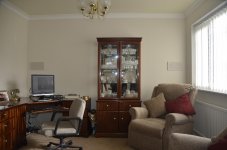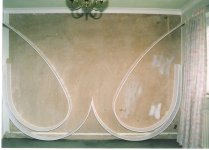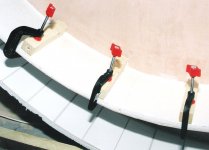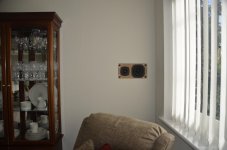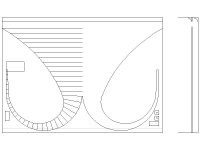I believe that horns are very worth the inconvenience of their outrageous size - but sadly it isn't my opinion that counts. So, employing a degree of subterfuge, I hid mine up the end of the lounge where no one would notice. To achieve this I first designed them to be very thin (150 mm or so) and then decorated them to look like the wall. As the 1st picture shows, apart from the drive covers, the finished horn is pretty much 'invisible'.
The 2nd picture shows it under construction, 'fences' of 150 mm ceramic tiles, fixed edge on to the prepared wall, define the horn profile (mine is bifurcated). The tiles are backed by an 'armature' of expanded polystyrene for rigidity as shown. Sheets of plasterboard the width and height of the room covers the front with a full width 150 mm deep slot, 100 mm down from the ceiling forming the mouth. Small throat boxes of HDMDF house the Audax 130 carbon speakers. Finally the plasterboard is completely wallpapered including the mouth and finished to match the décor.
My horns have been in use for 12 years or so. The sound really is delightful, bass in particular is so smooth – not sub-sonic perhaps but firm and honest with no hint of boom, hangover or coloration. On my OD class A amps they perform much like a 60w system so efficiency must be around 12% or so – proper horn drivers would no doubt improve that.
Twelve years on they still bring a smile to my face every time I use them.
The 2nd picture shows it under construction, 'fences' of 150 mm ceramic tiles, fixed edge on to the prepared wall, define the horn profile (mine is bifurcated). The tiles are backed by an 'armature' of expanded polystyrene for rigidity as shown. Sheets of plasterboard the width and height of the room covers the front with a full width 150 mm deep slot, 100 mm down from the ceiling forming the mouth. Small throat boxes of HDMDF house the Audax 130 carbon speakers. Finally the plasterboard is completely wallpapered including the mouth and finished to match the décor.
My horns have been in use for 12 years or so. The sound really is delightful, bass in particular is so smooth – not sub-sonic perhaps but firm and honest with no hint of boom, hangover or coloration. On my OD class A amps they perform much like a 60w system so efficiency must be around 12% or so – proper horn drivers would no doubt improve that.
Twelve years on they still bring a smile to my face every time I use them.
Attachments
Neat stealth install- the compression chamber seems very big though. Do you notice any noise from the wallpaper over the mouth?
Neat stealth install- the compression chamber seems very big though. Do you notice any noise from the wallpaper over the mouth?
No issues with the wallpaper, badman, it was a bit of a risk I know but it does work well. I think the mouth pressures are much too low to excite it – you don't see the slightest vibration or movement of any sort at all.
The compression chamber(s) volume is actually 5400 cc working into a 48 cm2 throat, some 0.56S for the Audax, would that be about right d'you think ?
Beautiful! Reminds me a bit of Eso's all-horn-rig that I saw years ago at the High Efficiency section of Audioasylum. Only this is a fair bit smaller and stealthier.
The compression chamber(s) volume is actually 5400 cc working into a 48 cm2 throat, some 0.56S for the Audax, would that be about right d'you think ?
Maybe? Not ever designed a horn like this one. Anyway, my compliments on one of the coolest installs I've seen 🙂
That's very cool, but where are the speakers? 😉
The speakers, Pano, are in compression chambers attached to the throat ends. Made from tiles BTW not MDF as I said earlier – only the baffles are MDF. I don't have a construction picture of them but you can see the left speaker minus its grille in the pic below. The throat enters the chamber behind the lower right grille popper.
I'm pleased you like them.
Attachments
I believe that horns are very worth the inconvenience of their outrageous size - but sadly it isn't my opinion that counts. So, employing a degree of subterfuge, I hid mine up the end of the lounge where no one would notice. To achieve this I first designed them to be very thin (150 mm or so) and then decorated them to look like the wall.
I believe this is a good example of what's called "high-power diplomacy" 😀
Honestly, in all this time I've been browsing the web for ultimate speaker solutions this is the first time I've come across this design - so top marks for originality there.
I've come across "spiral horns" that can be hung on the wall but they come nowhere near the size displayed here.
I've seen floor installations put in place while the house is still being built or horns built into the wall that virtually require the size of a small room to be sacrificed but neither are practical or realistic for almost all listeners.
What makes this installation remarkable is that despite its size, it does not necessitate a permanent or expensive solution. The same effect could be achieved using a fake partition built with plasterboard or plywood that can be designed to be removable.
The 2nd picture shows it under construction, 'fences' of 150 mm ceramic tiles, fixed edge on to the prepared wall
...
The tiles are backed by an 'armature' of expanded polystyrene for rigidity as shown.
What made you decide on tiles as a material for this purpose - aside from convenience ?
Finally the plasterboard is completely wallpapered including the mouth and finished to match the décor.
This is very ingenious. Have you been able to establish whether there is a loss in output power due to the wallpaper ? perhaps there is an optimal tension that can be applied to the wallpaper.
Twelve years on they still bring a smile to my face every time I use them.
I've believe you've opened a new path for aspiring audiophiles.. 🙂
Last edited:
I don't get it - is the mouth a large wide rectangular opening at the wall ceiling interface and wall paper physically covers the mouth and vibrates like a passive radiator for the mouth?
You can produce a very accurate profile with tiles plus they come in a wide range of sizes, are readily available, easily worked, acoustically dead - and they're cheap. I think I first saw them used on Kappelmeister transmission lines.What made you decide on tiles as a material for this purpose - aside from convenience ?
No I haven't, testing for things like this isn't really practical in domestic situation. The wall paper isn't an issue, the real problem is a lack of suitable, small, affordable, horn-optimised drivers. If I ever do another this is what I'd be looking at.Have you been able to establish whether there is a loss in output power due to the wallpaper ? perhaps there is an optimal tension that can be applied to the wallpaper.
I don't get it - is the mouth a large wide rectangular opening at the wall ceiling interface and wall paper physically covers the mouth and vibrates like a passive radiator for the mouth?
Nearly. Attached to the ceiling is a full width 100mm plasterboard 'wall' that supports the polystyrene coving. It also provides a fixing for top of the wallpaper. The mouth is the gap between this 'wall' and the main front plasterboard - at times like this I wish I'd taken more pics.
It does perform like a passive radiator, yes, but its very much larger so its excursions are tiny - you can't see or feel any 'vibration' at the mouth.
I still don't quite get it - a sketch of the side profile would be useful. I think you are saying that a 100 mm tall panel hangs from the ceiling down and this panel is at the same plane as the main baffle wall which extends up from the floor to a gap between the top suspended panel. What is the width of this mouth gap? The gap is covered with polyethylene plastic over which you attach wall paper. This membrane is the passive radiator for the horn mouth and because it is so large the vibration displacement is very small. Indeed it must vibrate and you should be able to feel the vibrations otherwise no sound would get through. However you did it - it is completely invisible to the eye - especially with the addition of the crown molding in the 100 mm tall piece that is suspended from the ceiling. Have you ever measured the response? I am curious what SPL levels you can achieve, how deep the bass extension is, and how much distortion is there at the sub 50 Hz frequencies.
Nice work though!
Nice work though!
You describe it well xrk971. The picture is one of my working drawings. The upper right detail should clarify things. The mouth is the full room width (about 11ft) by 100mm (sorry mixed dimensions). I've omitted the wallpaper for clarity, it covers the front plasterboard from floor to ceiling .I still don't quite get it - a sketch of the side profile would be useful.
Have you ever measured the response? I am curious what SPL levels you can achieve, how deep the bass extension is, and how much distortion is there at the sub 50 Hz frequencies.
Sadly no. I'm not equipped to do such testing. I simply offer my effort to anyone intrigued enough to follow a similar path.
Thank you, that's most kind.Nice work though!
Attachments
...the real problem is a lack of suitable, small, affordable, horn-optimised drivers. If I ever do another this is what I'd be looking at.
Fostex comes to mind as a first candidate - whether they're your cup of tea is another matter. While not exactly cheap they do include some cheap models in their line-up.
Then there's second hand Lowthers of course but that's a whole different ball game - as are most other vintage speakers of that calibre.
Fostex comes to mind as a first candidate - whether they're your cup of tea is another matter. While not exactly cheap they do include some cheap models in their line-up.
Yes, Fostex. I'm not certain they're fully optimised for horn use - I'd be looking for low compliance, higher impedance, say 15 ohms, and a co-ax tweeter. But I did get a couple of those cheapo 'Chinese' looky-likey 100 mm 4 ohm dual-cone things on eBay a while back. They look do nice enough but one has a very tilted spider so I reckon their either prep-production or factory rejects, but I've hearted quite good reports on them. Id need to adjust my amps to try them out and rather than do that, I think I'd prefer a rebuild with updates - that's a winter project though.
- Status
- Not open for further replies.
- Home
- Loudspeakers
- Multi-Way
- Covert Bifurcated Horns
